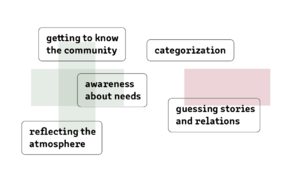LED2LEAP 2020 - Nuertingen Team 3: Difference between revisions
Jump to navigation
Jump to search
No edit summary |
|||
| Line 53: | Line 53: | ||
<gallery caption=" " widths="200px" heights="150px" perrow="5"> | <gallery caption=" " widths="200px" heights="150px" perrow="5"> | ||
File:Location.png|Location | File:Location.png|Location | ||
File:Characteristics of Klein-Tischardt.png|Characteristics | File:Characteristics of Klein-Tischardt.png|Characteristics and known issues | ||
</gallery> | </gallery> | ||
Revision as of 12:14, 28 April 2020
>>>back to working groups overview
| Area | Klein-Tischardt | |
| Place | Nürtingen | |
| Country | Germany | |
| Topics | Diversity | |
| Author(s) | Leila Hoffmann, Carolin Lenz, Chiara Marquart, Vanessa Thaser | |
Landscape Democracy Rationale
- Why do you think this community context is relevant from a landscape democracy perspective? What is your hypothesis considering the landscape democracy challenges?
- Format: 3-4 sentences
Location and scope
- map editor
- District Klein-Tischardt, 72622 Nürtingen
Phase A: Mapping your Community
Welcome to your community and its landscape
- district Klein-Tischardt between the rivers Neckar & Steinach
- main road divides KT in two
- buildings with rural character
- unused squares & closeness to the river offers potential
- agricultural background
- high diversity
- high average age
Groups of actors and stakeholders in your community
- Which groups/sub-communities are there? What are their needs and aspirations with regard to the landscape? Which groups are more visible? Which are less visible? What do we not know? (max 200 signs)
Relationships between your actors and groups
- How would you describe the power relationship between the groups?
- Which groups may have shared interests and which are these? (max 200 signs)
Summary of your learnings from the transnational discussion panel on April 22
On April 22 you will present the PPT version of this first assignment to other seminar groups working in other geographical community contexts. Please give here a short summary of your learnings during this presentation, for example:
- Other analytical approaches
- Other representation styles
- Other value schemes: any surprises?
- Constructive comments we received on our presentation
Theory reflection
- Reflect on at least three readings from the first section 'Democratic Landscape Transformation
- You can choose references from our reading list or suggest others
- Scope: 250 words
References
- give a full list of the references you have used for this section
Phase B: Democratic Landscape Analysis and Assessment
* template coming
Phase C: Collaborative Visioning and Goal Setting
* template coming
Phase D: Collaborative Design, Transformation and Planning
* template coming
Phase E: Collaborative Design, Transformation and Planning
* template coming
= Phase E: Collaborative Evaluation and Future Agendas * template coming
Process Reflection
- Reflect in your intercultural and interdisciplinary team on the outcomes of your study
- Which limitations were you facing?
- What have you learnt from each other?
- What would you do differently next time?
- You can also use diagrams/visuals
- 250 words text






